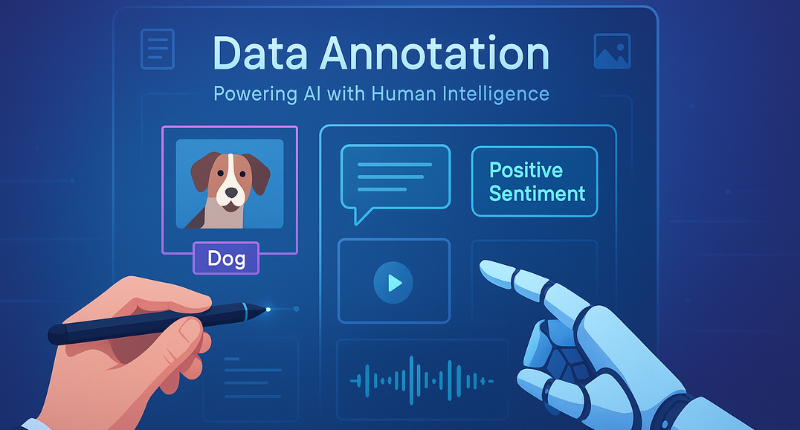
We use cookies to ensure that we give you the best experience on our website.
By using this site, you agree to our use of cookies. Find out more.

In today's AI-driven world, data is at the core of intelligent systems today; but raw data alone is ineffective without context and meaning. That's where data annotation, data labelling, and AI tagging comes into play.
Data annotation (also known as data labelling) is the process of labeling or tagging raw data such as text, images, audio, and video to make it understandable for machine learning (ML) and artificial intelligence (AI) models.
In simple terms, it's how humans teach AI systems to interpret the world around them. Without properly annotated data, even the most advanced AI algorithms can't recognize objects, understand speech, or analyze emotions.
For instance, when an annotator labels an image of a dog as 'Dog' that label becomes part of the training data. Over thousands of examples, the AI learns to recognize dogs on its own. This is the backbone of applications like image recognition, chatbots, self-driving cars, and voice assistants.
Professional data labelling, and AI tagging services play a vital role in ensuring this process is accurate, scalable, and tailored to specific business or industry needs.
High-quality annotation directly impacts how well AI systems perform. Without well-labeled data, even advanced algorithms fail to interpret real-world scenarios correctly.
Here's why data annotation is so important:
From autonomous vehicles to healthcare diagnostics, AI annotation enables machines to make sense of complex data with human-like precision.
Different industries require different labeling techniques based on their data and use cases. Below are the main types of data annotation and data labelling used in AI and machine learning projects:
| Type | Description | Common Use Cases |
| Image Annotation | Tagging or outlining objects in images using bounding boxes, polygons, or segmentation. | Self-driving cars, retail inventory, medical imaging |
| Video Annotation | Labeling objects frame-by-frame to track motion and behavior. | Sports analytics, surveillance, robotics. |
| Text Annotation | Labeling words, entities, sentiment, or intent for language understanding. | Chatbots, sentiment analysis, search optimization |
| Audio Annotation | Tagging sounds, voices, or tones with metadata like language, emotion, or background noise. | Voice assistants, emotion recognition, transcription. |
| Time Series Annotation | Marking patterns or anomalies in sequential or sensor data. | IoT devices, healthcare monitoring, predictive maintenance |
Even though it sounds straightforward, large-scale annotation has its hurdles. Leading data annotation companies constantly work to overcome these:
| Challenges | Description | Solution Approach |
| Quality Control | Inconsistency among annotators affects accuracy. | Multi-stage reviews & validation layers. |
| Scalability | Large datasets require huge manual effort. | Hybrid human-AI annotation tools. |
| Domain Expertise | Specialized data (medical, legal, etc.) needs expert annotators. | Domain-specific training and teams. |
| Bias & Ethics | Human bias can lead to unfair AI outcomes. | Diversity in data and strict ethical guidelines. |
| Tool Selection | Wrong tools reduce efficiency. | Custom-built data annotation solutions tailored per project. |
Leading AI tagging and data annotation services overcome these challenges using automation, human review, and multi-stage quality checks.
Data annotation, data labelling, and AI tagging form the bridge between raw data and intelligent action. Here's how they contribute to building smarter AI models:
High-quality data annotation transforms machine learning models from functional to truly intelligent.
If you're planning to build AI systems or train ML models, here's how to start:
Outsourcing to reliable data annotation service providers often saves time, ensures data security, and guarantees higher quality at scale.
When selecting a data annotation company, consider the following factors:
A trusted partner offering end-to-end AI annotation services helps organizations focus on innovation while ensuring labeled data is accurate and reliable.
Data annotation drives innovation across industries:
Emerging trends include synthetic data generation, active learning, and automated labeling through large language models (LLMs), making annotation faster and more efficient.
Data annotation is the cornerstone of all AI and ML systems. It transforms raw, unstructured data into actionable insights that power intelligent technologies.
From image annotation for computer vision to text annotation services for NLP, the right labeling strategy determines how effectively your AI system performs.
By partnering with experienced data annotation companies like VertexPlus, organizations can ensure accuracy, reduce bias, and accelerate their journey toward smarter, data-driven innovation.
Q1: What is data annotation in AI?
Data annotation (or data labelling) is the process of tagging raw data (images, text, audio, video) with labels so that machine learning models can learn from it.
Q2: What are the main types of data annotation?
The main types include image annotation, video annotation, text annotation, audio annotation, and time-series annotation.
Q3: How do annotation services ensure quality?
They use multi-level review, consensus checks, guidelines, benchmarking metrics like inter-annotator agreement, and periodic audits.
Q4: Can a business do annotation in-house?
Yes, but for large-scale or high-quality needs, many companies prefer outsourcing to professional data annotation companies or AI data labeling providers.
Q5: What is the cost or timeframe for annotation projects?
Costs vary by data type, complexity, domain, and scale. Simple labeling might cost a few cents per item; complex medical annotations can cost more and take longer.
Leave a Comment
Your email address will not be published.